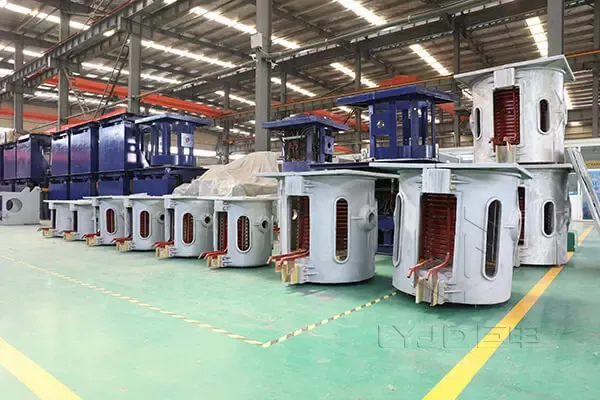Induction furnace plant
Induction Furnace Plant for Sale: Revolutionize Your Metal Melting and Processing Operations

Judian induction furnace supplier
In the realm of metal manufacturing and processing, an induction furnace plant stands as a cornerstone of efficiency, precision, and productivity. Our state-of-the-art induction furnace plants are designed to meet the diverse needs of various industries, offering a seamless solution for melting and processing metals with unrivaled performance. This article will provide you with a comprehensive overview of our induction furnace plants on sale, highlighting their exceptional features, advantages, and the value they can bring to your business.
I. Introduction to Induction Furnace Plants
An induction furnace plant is a sophisticated setup that utilizes electromagnetic induction to heat and melt metals. It consists of an induction furnace, power supply unit, cooling system, and various control mechanisms. This technology offers a cleaner, faster, and more energy-efficient alternative to traditional furnace methods for melting metals such as steel, aluminum, copper, and more. Our induction furnace plants are engineered with the latest advancements in the field to ensure optimal operation and outstanding results.
II. Key Components of Our Induction Furnace Plants
Induction Furnace
The heart of our induction furnace plant is the induction furnace itself. It is designed with a crucible where the metal to be melted is placed. The furnace generates a powerful alternating magnetic field that induces eddy currents within the metal, causing it to heat up rapidly and reach the melting point. Our induction furnaces come in different capacities, ranging from small laboratory-scale units to large industrial-sized furnaces capable of handling tons of metal per hour, allowing you to choose the one that suits your specific production requirements.
Power Supply Unit
The power supply unit is crucial for providing the necessary electrical energy to the induction furnace. It converts the incoming electrical power from the grid into the high-frequency alternating current required by the furnace. Our power supply units are equipped with advanced electronics that ensure stable and efficient power delivery, with adjustable output frequencies and power levels to accommodate different melting processes and metal types.
Cooling System
To prevent overheating of the induction furnace and its components, a reliable cooling system is incorporated. This system circulates coolant, usually water or a specialized cooling fluid, around the furnace coils and other heat-generating parts. Our cooling systems are designed to maintain optimal operating temperatures, ensuring the longevity and continuous operation of the furnace plant. They are equipped with temperature sensors and automatic control mechanisms to adjust the cooling rate as needed.
Control Mechanisms
Our induction furnace plants feature sophisticated control mechanisms that allow for precise regulation of the melting process. Operators can set and monitor parameters such as temperature, power input, melting time, and more through user-friendly interfaces. These controls enable consistent and repeatable melting operations, ensuring the quality and uniformity of the melted metal. Additionally, the control systems can be integrated with factory automation systems for seamless production line integration. III. Features and Advantages of Our Induction Furnace Plants
High Energy Efficiency
One of the most significant advantages of our induction furnace plants is their exceptional energy efficiency. Compared to traditional furnaces, induction furnaces convert a much higher percentage of electrical energy into useful heat for melting metals. This not only reduces energy consumption but also leads to significant cost savings in the long run. The efficient use of energy also makes our plants more environmentally friendly, contributing to a reduction in carbon emissions.
Rapid Melting Speed
Our induction furnace plants are capable of achieving rapid melting speeds. The electromagnetic induction process heats the metal directly within the crucible, bypassing the need for a long preheating period as in some traditional furnaces. This enables quick start-up and short melting times, allowing for increased productivity and faster turnaround times in metal processing operations. For example, a medium-sized induction furnace in our plant can melt a batch of steel in a fraction of the time it would take a comparable traditional furnace.
Precise Temperature Control
Precise temperature control is essential for producing high-quality melted metal. Our induction furnace plants offer accurate temperature regulation within a narrow range. The control mechanisms can maintain the desired melting temperature with high precision, ensuring that the metal is melted uniformly and without overheating or underheating. This is particularly crucial for alloying processes where the correct temperature is vital for achieving the desired chemical composition and mechanical properties of the final product.
Clean and Environmentally Friendly
Induction furnace plants operate with minimal emissions compared to some traditional furnace methods. There is no combustion process involved, so there are no smoke, soot, or harmful gases released during the melting operation. This not only provides a cleaner working environment for operators but also reduces the need for extensive air pollution control measures. Additionally, the efficient energy use further contributes to the plant's environmental friendliness.
Versatility in Metal Processing
Our induction furnace plants are highly versatile and can handle a wide range of metal types and alloys.